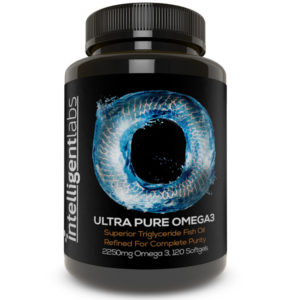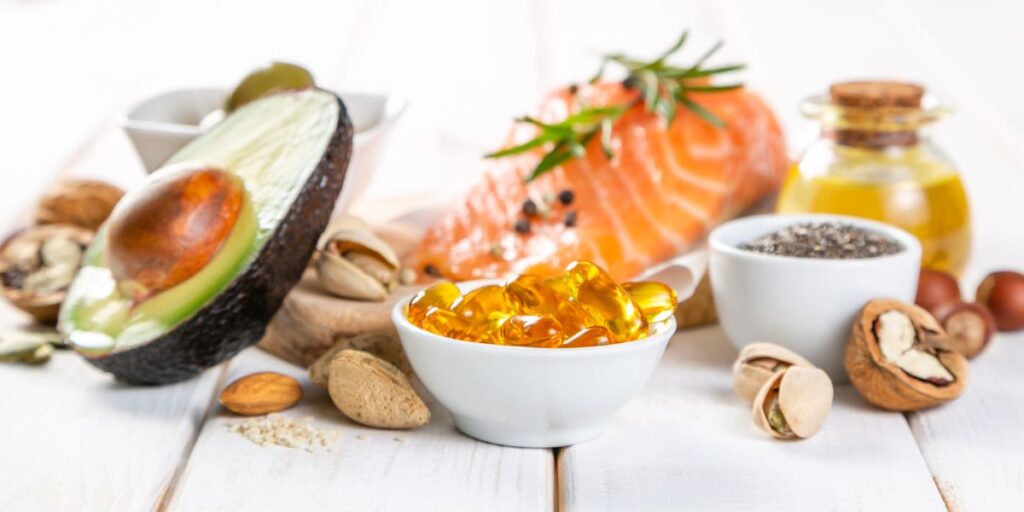If you’ve ever taken fish oil supplements like our Ultra Pure Omega-3 Fish Oil, then you’re probably well acquainted with EPA and DHA. They’re 2 of the most popular types of omega-3 fatty acids.
But did you know there are 11 omega-3 fatty acids in nature? They’re not created equal though, and only a few of them are involved in human physiology. Let’s get to know the most important types of omega-3 in this blog post!
Table of Contents
What exactly is omega-3?
Omega-3 is an essential nutrient found in fish, krill, algae, and some plants, nuts, and seeds. The human body can’t make them, so we need to take omega-3 from either food or supplements. As you’ll see below, taking these fatty acids regularly is key to preventing health problems.
But they said fat is “bad”, so why are omega-3 fatty acids “good”?
Well, not all fat is bad. You’re probably thinking of saturated fat and trans fat. Yes, these two types of fat are bad news.
However, omega-3 fatty acids belong to the polyunsaturated fats (PUFA) category, meaning they’re actually good and healthy for us. Several studies have shown that PUFAs can lower bad cholesterol, decreasing heart disease risk (1).
But that’s not the extent of PUFAs – and omega-3’s – health benefits. Keep reading to learn more!
The most important types of omega-3 and where to find them
Out of the 11 identified omega-3s, there are 3 that have been studied for decades:
- DHA (Docosahexaenoic acid)
- EPA (Eicosapentaenoic acid)
- ALA (Alpha-linolenic acid)
And there’s also a fourth type that has shown some positive findings so far:
- DPA (Docosapentaenoic acid)
The marine omega-3s

The marine omega-3s are those found in fish, krill, and other seafood. These are EPA, DHA, and DPA.
You will usually find them in fish oil supplements like our Ultra Pure Omega-3 Fish Oil which uses fish sourced from a certified “Friends of the Sea” supplier. We also only use wild mackerel, sardine, and anchovy from pristine Antarctic waters.
There’s no official recommended daily allowance specified yet for marine omega-3s. Though various health organizations have their own suggestions on how much omega-3 per day is safe.
The plant omega-3
The sole plant omega-3 is ALA. It is present in flaxseed, chia seeds, walnuts, soybeans, pumpkins, avocado, and other nuts and seeds.
Out of all the omega-3’s, only ALA has an official recommended daily intake (2):
| Life Stage | Recommended Amount of ALA |
| Teen boys 14–18 years | 1.6 g |
| Teen girls 14–18 years | 1.1 g |
| Men | 1.6 g |
| Women | 1.1 g |
| Pregnant teens and women | 1.4 g |
| Breastfeeding teens and women | 1.3 g |
Interestingly, the human body can convert very small amounts of ALA to DHA and EPA, which should help if you’re vegetarian or vegan. However, in order to get the same amounts of DHA and EPA as you would from marine sources, you will need to consume high amounts of ALA.
The “other” omega-3s
We won’t go into detail with these 7 other types of omega-3 found in nature since they aren’t considered vital to human health, but it’s still good-to-know info:
- Hexadecatrienoic acid (HTA)
- Stearidonic acid (SDA)
- Eicosatrienoic acid (ETE)
- Eicosatetraenoic acid (ETA)
- Heneicosapentaenoic acid (HPA)
- Tetracosapentaenoic acid
- Tetracosahexaenoic acid (Nisinic acid)
What are the benefits of these 4 important types of omega-3?
Collectively, the whole range of omega-3 fatty acids has a lot of science-backed health benefits. We’ve compiled 20+ benefits in our Omega-3 Ultimate Supplement Guide if you want to know more about them. But let’s see what 4 of the most important types of omega-3 fatty acids have to offer:
DHA
DHA may arguably be the best type of omega-3 fatty acid. This is mainly because of DHA’s significant presence in the brain (much more than EPA) and its important role in brain health.
In addition to the brain, DHA is also found in large amounts in the skin and retina (eyes). Moreover, DHA is naturally present in human breastmilk, signifying its importance in a baby’s development. It’s so vital to a child’s brain and eye development that many infant formula brands now add DHA to their products (3).
Low levels of DHA is associated with a decline in cognitive function. People with dementia and Alzheimer’s also have decreased DHA levels in the brain. Taking DHA, alone or in combination with EPA, may help improve memory function in older adults as well as reduce the risk of dementia and Alzheimer’s (4) (5).
EPA
EPA is said to be a more powerful anti-inflammatory than DHA. The body uses EPA to produce anti-inflammatory molecules known as eicosanoids, which help regulate inflammation. Eicosanoids derived from omega-3 fatty acids are anti-inflammatory, while those derived from omega-6 fatty acids are pro-inflammatory (6).
Many diseases are largely in part due to chronic inflammation. Examples include arthritis, heart disease, asthma, cancer, diabetes, Crohn’s disease, psoriasis, lupus, multiple sclerosis, and more. Fortunately, omega-3 fatty acids can also help manage various inflammatory and autoimmune diseases (7).
ALA
According to the European Food Safety Authority, ALA contributes to the maintenance of normal blood cholesterol levels. Higher intake of ALA may also be associated with lower cardiovascular risk (8).
Additionally, as mentioned above, ALA is a precursor to EPA and DHA though this isn’t the most efficient way to get high enough levels of EPA and DHA. ALA not converted into other forms is simply stored in the body or used as an energy source (9).
DPA
Considered the new kid on the block in the omega-3 fatty acids family, DPA is also a marine omega-3. Structurally, it’s most similar to EPA. And just like DHA, it’s also present in human breastmilk.
DPA’s health benefits also seem closely tied to other omega-3 fatty acids. For instance, its presence in breastmilk suggests that it may also play an important role in infant development like DHA (10). Moreover, it may also benefit immunity, heart health, and cognitive function (11).
Final words
Many studies on omega-3 fatty acids use fish oil supplements. As such, the marine omega-3s (specifically EPA and DHA) are associated with many of omega-3’s health benefits.
Moreover, the EPA/DHA ratios used in many successful trials were 60/40 or 3:2 EPA/DHA ratio. With this in mind, we made sure that our Ultra Pure Omega-3 Fish Oil follows this clinically recognized ratio.
Each serving contains 1,224mg EPA and 816mg DHA. And since we use superior triglyceride fish oil, our product naturally contains other omega-3 fatty acids too (each serving contains 210mg of these other omega-3s!).

